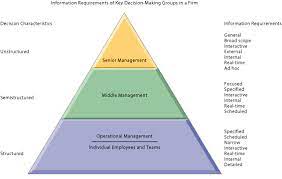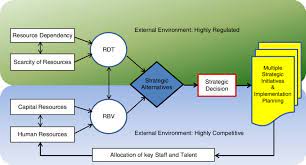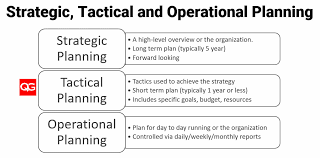Decision Making in Operations Management: Maximizing Efficiency and Effectiveness
Operations management plays a crucial role in the success of any organization. It involves overseeing the processes, resources, and activities that are necessary to produce goods or deliver services. Within this complex landscape, decision making becomes a critical component that can either drive efficiency and effectiveness or hinder progress.
In operations management, decision making encompasses a wide range of choices, from strategic planning to day-to-day operational decisions. These decisions directly impact factors such as cost, quality, productivity, customer satisfaction, and overall organizational performance. Therefore, it is imperative for operations managers to employ effective decision-making strategies to optimize outcomes.
One key aspect of decision making in operations management is the ability to analyze and interpret data. In today’s data-driven world, organizations have access to vast amounts of information collected from various sources such as production systems, supply chains, customer feedback, and market trends. By harnessing this data through analytics tools and techniques, operations managers can gain valuable insights that inform their decision-making process.
Another critical factor in effective decision making is considering both short-term and long-term implications. While short-term decisions may address immediate challenges or opportunities, they should align with the long-term goals and objectives of the organization. Operations managers must evaluate trade-offs between immediate gains and long-term sustainability to ensure decisions contribute to the overall success of the business.
Furthermore, involving cross-functional teams in the decision-making process can greatly enhance its effectiveness. Operations management often requires collaboration among various departments such as production, procurement, logistics, finance, and marketing. By engaging stakeholders from different areas of expertise and perspectives, organizations can benefit from diverse insights that lead to more well-rounded decisions.
Risk assessment is another crucial aspect when making decisions in operations management. Every decision involves a certain level of uncertainty or risk. Operations managers must consider potential risks associated with each alternative before making a choice. This includes evaluating factors such as market volatility, supply chain disruptions, regulatory changes, and technological advancements. By conducting thorough risk assessments, organizations can develop contingency plans and mitigate potential negative impacts.
Technology also plays a significant role in modern decision making within operations management. With the advent of advanced software solutions and automation tools, operations managers can optimize decision-making processes by leveraging real-time data, predictive analytics, and simulation models. These technologies enable faster and more accurate decision making, allowing organizations to respond promptly to changing market conditions or operational challenges.
In conclusion, decision making in operations management is a multifaceted process that requires a comprehensive understanding of the organization’s goals, available data, risks, and stakeholder perspectives. By employing effective decision-making strategies that incorporate data analysis, long-term considerations, cross-functional collaboration, risk assessment, and technological advancements, operations managers can maximize efficiency and effectiveness in their decision-making processes. Ultimately, this leads to improved operational performance and helps organizations stay competitive in today’s dynamic business environment.
6 Tips for Effective Decision Making in Operations Management
- Gather the facts
- Consider all options
- Weigh pros and cons
- Think long-term
- Get input from stakeholders
- Make a plan of action
Gather the facts
Gather the Facts: A Key Tip for Effective Decision Making in Operations Management
In the fast-paced world of operations management, making informed decisions is crucial to ensure smooth operations, enhance productivity, and achieve organizational goals. One essential tip that can significantly impact decision-making effectiveness is to gather the facts.
When faced with a decision, it’s essential to gather all relevant information and data before proceeding. This step allows operations managers to have a comprehensive understanding of the situation at hand and make well-informed choices.
Collecting facts involves conducting research, analyzing historical data, and seeking input from various sources. It may include examining production reports, customer feedback, market trends, financial statements, or even consulting with subject matter experts within the organization.
By gathering the facts, operations managers gain valuable insights into the problem or opportunity they are facing. They can identify patterns, trends, and potential risks associated with different alternatives. This information provides a solid foundation for decision making and helps minimize biases or assumptions that could lead to suboptimal outcomes.
Moreover, gathering facts enables data-driven decision making. In today’s digital age, organizations have access to vast amounts of data generated from various sources. By harnessing this data through analytics tools and techniques, operations managers can uncover hidden patterns or correlations that may not be immediately apparent. These insights empower them to make decisions based on evidence rather than intuition alone.
Additionally, gathering facts fosters transparency and accountability within an organization. When decisions are based on accurate information rather than personal opinions or biases, it becomes easier to justify choices and communicate them effectively to stakeholders. This transparency builds trust among team members and ensures everyone understands why certain decisions were made.
However, it’s important to note that gathering facts should not lead to analysis paralysis or excessive delays in decision making. The goal is not to gather every piece of information possible but rather to collect sufficient relevant data that enables confident decision making within reasonable timeframes.
In conclusion, gathering the facts is a vital tip for effective decision making in operations management. By collecting relevant information and data, operations managers can gain valuable insights, make informed choices, and minimize the risks associated with biased or uninformed decision making. Embracing this tip enhances decision-making effectiveness, drives organizational success, and contributes to overall operational excellence.
Consider all options
Consider All Options: A Key Tip for Effective Decision Making in Operations Management
In the realm of operations management, making informed decisions is crucial for achieving organizational success. One essential tip that can greatly enhance the decision-making process is to consider all available options before settling on a course of action.
When faced with a decision, it can be tempting to rush into choosing the first option that comes to mind or seems most convenient. However, this approach may limit potential opportunities and overlook alternative solutions that could yield better results. By taking the time to explore and evaluate all available options, operations managers can make more informed and strategic decisions.
Considering all options involves conducting thorough research and analysis. It requires gathering relevant information about each alternative, such as its potential benefits, risks, costs, and impacts on various aspects of the organization. This comprehensive evaluation allows operations managers to weigh the pros and cons of each option objectively.
By considering all options, operations managers can also foster creativity and innovation within their teams. Encouraging diverse perspectives and brainstorming different possibilities can lead to unique insights and out-of-the-box solutions. This approach promotes a culture of continuous improvement and helps organizations stay ahead in today’s competitive business landscape.
Moreover, considering all options helps mitigate potential biases or assumptions that may influence decision making. It ensures that decisions are based on objective analysis rather than personal preferences or preconceived notions. By challenging assumptions and exploring different avenues, operations managers can make more well-rounded decisions that align with organizational goals.
However, it is important to strike a balance between thorough evaluation and timely decision making. While considering all options is valuable, it should not lead to analysis paralysis or excessive delays in making choices. Operations managers must exercise judgment and prioritize based on urgency, available resources, and the potential impact of each decision.
In summary, considering all available options is a vital tip for effective decision making in operations management. By thoroughly researching alternatives, fostering creativity within teams, challenging biases, and striking a balance between analysis and action, operations managers can make informed choices that drive efficiency, productivity, and overall organizational success. Embracing this approach empowers organizations to adapt to changing circumstances, seize opportunities, and stay ahead in today’s dynamic business environment.
Weigh pros and cons
Weighing Pros and Cons: A Key Tip for Effective Decision Making in Operations Management
When it comes to decision making in operations management, one valuable tip that should never be overlooked is weighing the pros and cons. This simple yet powerful technique can help operations managers make informed choices that maximize efficiency and effectiveness.
The process of weighing pros and cons involves carefully considering the advantages and disadvantages of each available option before making a decision. By systematically evaluating the potential benefits and drawbacks, operations managers gain a clearer understanding of the potential outcomes associated with each choice.
One of the primary benefits of weighing pros and cons is that it helps identify the potential positive impacts of a decision. By listing out the pros, operations managers can assess how each alternative aligns with their organization’s goals, whether it’s increasing productivity, reducing costs, improving quality, or enhancing customer satisfaction. This analysis enables them to prioritize options that offer significant advantages.
On the other hand, considering the cons allows operations managers to evaluate potential risks or negative impacts associated with each option. It helps them identify potential obstacles or challenges that may arise from a particular decision. By recognizing these drawbacks in advance, operations managers can develop mitigation strategies or alternative plans to address potential issues effectively.
Weighing pros and cons also promotes a more comprehensive decision-making process by encouraging critical thinking and analysis. It helps operations managers consider multiple perspectives and factors rather than relying on personal biases or assumptions. This approach fosters a more objective evaluation of alternatives, leading to more well-rounded decisions.
Additionally, this technique aids in effective communication within cross-functional teams involved in decision making. By presenting a balanced assessment of both advantages and disadvantages, operations managers can facilitate meaningful discussions among team members. This collaborative approach encourages diverse viewpoints and ensures that all stakeholders have an opportunity to contribute their insights before reaching a consensus.
In conclusion, weighing pros and cons is an invaluable tip for effective decision making in operations management. By systematically evaluating the potential benefits and drawbacks of each option, operations managers can make informed choices that align with their organization’s goals and objectives. This technique promotes critical thinking, enhances communication, and helps identify potential risks or obstacles. By incorporating this tip into their decision-making process, operations managers can optimize outcomes and drive success in their organizations.
Think long-term
When it comes to decision making in operations management, one valuable tip to keep in mind is to think long-term. While it may be tempting to focus solely on immediate gains or challenges, considering the long-term implications of your decisions can lead to more sustainable and successful outcomes.
In operations management, decisions are made with the goal of optimizing efficiency, productivity, and overall organizational performance. However, these decisions should not be made in isolation or solely based on short-term gains. Instead, they should align with the long-term objectives and strategic direction of the organization.
Thinking long-term involves taking into account factors such as market trends, customer demands, technological advancements, and industry changes. By considering these elements, operations managers can make informed decisions that position their organization for future success.
For example, when choosing suppliers or vendors, it is important to evaluate not only their immediate cost-effectiveness but also their reliability, quality standards, and ability to adapt to future needs. Similarly, when investing in new equipment or technology, it is crucial to assess their long-term benefits and potential for scalability.
Thinking long-term also means considering the impact of decisions on employees and stakeholders. For instance, implementing changes in processes or systems may require training or reorganization efforts. Taking into account the potential challenges and benefits for employees can help ensure a smoother transition and maintain morale.
By incorporating a long-term perspective into decision making in operations management, organizations can avoid short-sighted choices that may provide temporary gains but hinder progress in the future. It allows for a more holistic evaluation of alternatives and encourages strategic thinking that aligns with overall business objectives.
Ultimately, thinking long-term enables operations managers to make decisions that contribute to sustainable growth and competitive advantage. It helps organizations navigate uncertainties and adapt proactively to changing market conditions. By keeping this tip in mind during decision-making processes, operations managers can set their organizations on a path towards long-term success.
Get input from stakeholders
In the realm of operations management, one valuable tip that can significantly enhance decision making is to actively seek input from stakeholders. Stakeholders are individuals or groups who have a vested interest in the outcomes of a particular decision. By involving them in the decision-making process, operations managers can tap into a wealth of knowledge and perspectives that can lead to more informed and effective decisions.
Stakeholders can include employees at various levels, customers, suppliers, partners, and even regulatory bodies. Each stakeholder brings unique insights and experiences that can shed light on different aspects of the decision at hand. By engaging stakeholders early on and throughout the decision-making process, operations managers can gather valuable input that helps identify potential risks, uncover hidden opportunities, and ensure alignment with organizational goals.
One benefit of involving stakeholders is the diversity of perspectives they offer. Different stakeholders possess varying levels of expertise, experiences, and interests related to the decision being made. This diversity helps avoid biases and promotes a more holistic view of the situation. By considering multiple viewpoints, operations managers can gain a comprehensive understanding of potential implications and make more well-rounded decisions.
Furthermore, involving stakeholders fosters a sense of ownership and commitment to the decision-making process. When individuals feel their opinions are valued and their voices are heard, they become more invested in the outcomes. This engagement leads to increased accountability and collaboration among stakeholders as they work together towards achieving shared goals.
It is important to note that involving stakeholders does not mean blindly accepting every suggestion or opinion put forward. Operations managers must carefully evaluate each input based on its merits and relevance to the decision at hand. Not all suggestions may be feasible or aligned with organizational objectives. However, by considering diverse perspectives, operations managers can make more informed judgments about which inputs should be incorporated into the final decision.
In conclusion, seeking input from stakeholders is a valuable tip for effective decision making in operations management. By actively involving individuals or groups with a vested interest in the decision, operations managers can tap into a wealth of knowledge and perspectives that help inform and shape the decision-making process. This approach promotes diversity of thought, fosters ownership, and ultimately leads to more informed and effective decisions that align with organizational goals.
Make a plan of action
One of the most valuable tips for decision making in operations management is to make a plan of action. When faced with complex decisions, having a clear roadmap can help guide the decision-making process and ensure that actions are taken in a structured and organized manner.
Making a plan of action involves breaking down the decision into smaller, manageable steps. Start by clearly defining the problem or objective at hand. What is the desired outcome? What are the key factors to consider? By clearly articulating these elements, you set the foundation for your decision-making process.
Next, identify and evaluate potential alternatives or courses of action. Consider factors such as cost, feasibility, impact on resources, and alignment with organizational goals. This step allows you to assess different options and determine which one is most likely to achieve your desired outcome.
Once you have evaluated your alternatives, it’s time to develop a detailed action plan. This plan should outline specific tasks, responsibilities, timelines, and resources required for each step of the decision-making process. By breaking down the decision into actionable steps, you create a clear roadmap that everyone involved can follow.
Implementing your plan requires effective communication and coordination among team members or departments involved in executing the decision. Clearly communicate roles and responsibilities, provide necessary resources, and establish channels for ongoing feedback and collaboration.
As you execute your plan of action, it’s important to monitor progress regularly. Assess whether each step is being completed as planned and evaluate any deviations or roadblocks that may arise along the way. This allows you to make necessary adjustments in real-time and ensure that your decision remains on track.
Finally, evaluate the outcomes of your decision-making process once it has been fully implemented. Did it achieve the desired results? Were there any unforeseen consequences? Reflecting on these outcomes provides valuable insights for future decision making and helps improve processes within operations management.
By making a plan of action for your decisions in operations management, you establish a structured approach that increases the likelihood of success. It provides clarity, accountability, and a roadmap for executing decisions effectively. So, next time you face a complex decision in operations management, remember to take the time to make a plan of action and set yourself up for success.




